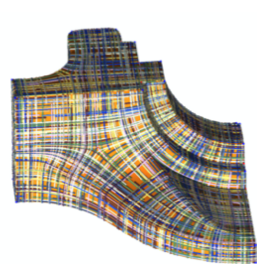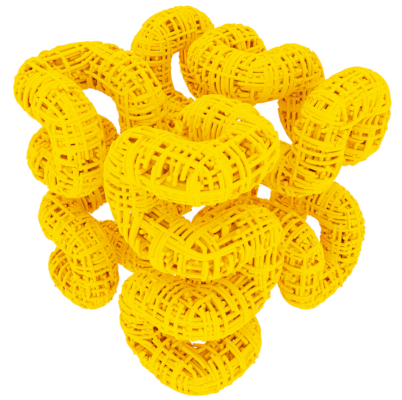
We present a method for designing smooth cross fields on surfaces that automatically align to sharp features of an underlying geometry. Our approach introduces a novel class of energies based on a representation of cross fields in the spherical harmonic basis. We provide theoretical analysis of these energies in the smooth setting, showing that they penalize deviations from surface creases while otherwise promoting intrinsically smooth fields. We demonstrate the applicability of our method to quad meshing and include an extensive benchmark comparing our fields to other automatic approaches for generating feature-aligned cross fields on triangle meshes.

Field-guided parameterization methods have proven effective for quad meshing of surfaces; these methods compute smooth cross fields to guide the meshing process and then integrate the fields to construct a discrete mesh. A key challenge in extending these methods to three dimensions, however, is representation of field values. Whereas cross fields can be represented by tangent vector fields that form a linear space, the 3D analog—an octahedral frame field—takes values in a nonlinear manifold. In this work, we describe the space of octahedral frames in the language of differential and algebraic geometry. With this understanding, we develop geometry-aware tools for optimization of octahedral fields, namely geodesic stepping and exact projection via semidefinite relaxation. Our algebraic approach not only provides an elegant and mathematically sound description of the space of octahedral frames but also suggests a generalization to frames whose three axes scale independently, better capturing the singular behavior we expect to see in volumetric frame fields. These new odeco frames, so called as they are represented by orthogonally decomposable tensors, also admit a semidefinite program–based projection operator. Our description of the spaces of octahedral and odeco frames suggests computing frame fields via manifold-based optimization algorithms; we show that these algorithms efficiently produce high-quality fields while maintaining stability and smoothness.
@article{10.1145/3366786,
author = {Palmer, David and Bommes, David and Solomon, Justin},
title = {Algebraic Representations for Volumetric Frame Fields},
year = {2020},
issue_date = {April 2020},
publisher = {Association for Computing Machinery},
address = {New York, NY, USA},
volume = {39},
number = {2},
issn = {0730-0301},
url = {https://doi.org/10.1145/3366786},
doi = {10.1145/3366786},
journal = {ACM Trans. Graph.},
month = apr,
articleno = {Article 16},
numpages = {17},
keywords = {convex algebraic geometry, octahedral frame fields, Hexahedral meshing, convex relaxations}
}

A major challenge in line drawing vectorization is segmenting the input bitmap into separate curves. This segmentation is especially problematic for rough sketches, where curves are depicted using multiple overdrawn strokes. Inspired by feature-aligned mesh quadrangulation methods in geometry processing, we propose to extract vector curve networks by parametrizing the image with local drawing-aligned integer grids. The regular structure of the grid facilitates the extraction of clean line junctions; due to the grid's discrete nature, nearby strokes are implicitly grouped together. We demonstrate that our method successfully vectorizes both clean and rough line drawings, whereas previous methods focused on only one of those drawing types.
@Article{SBBB20,
author = "Stanko, Tibor and Bessmeltsev, Mikhail and Bommes, David and Bousseau, Adrien",
title = "Integer-Grid Sketch Simplification and Vectorization",
journal = "Computer Graphics Forum (Proceedings of the Eurographics Symposium on Geometry Processing)",
number = "5",
volume = "39",
pages = "149--161",
month = "jul",
year = "2020",
keywords = "line drawing, vectorization, grid parametrization",
url = "http://www-sop.inria.fr/reves/Basilic/2020/SBBB20"
}

Quad meshes as a surface representation have many conceptual advantages over triangle meshes. Their edges can naturally be aligned to principal curvatures of the underlying surface and they have the flexibility to create strongly anisotropic cells without causing excessively small inner angles. While in recent years a lot of progress has been made towards generating high quality uniform quad meshes for arbitrary shapes, their adaptive and anisotropic refinement remains difficult since a single edge split might propagate across the entire surface in order to maintain consistency. In this paper we present a novel refinement technique which finds the optimal trade-off between number of resulting elements and inserted singularities according to a user prescribed weighting. Our algorithm takes as input a quad mesh with those edges tagged that are prescribed to be refined. It then formulates a binary optimization problem that minimizes the number of additional edges which need to be split in order to maintain consistency. Valence 3 and 5 singularities have to be introduced in the transition region between refined and unrefined regions of the mesh. The optimization hence computes the optimal trade-off and places singularities strategically in order to minimize the number of consistency splits — or avoids singularities where this causes only a small number of additional splits. When applying the refinement scheme iteratively, we extend our binary optimization formulation such that previous splits can be undone if this prevents degenerate cells with small inner angles that otherwise might occur in anisotropic regions or in the vicinity of singularities. We demonstrate on a number of challenging examples that the algorithm performs well in practice.
@article{Lyon:2020:Cost,
title = {Cost Minimizing Local Anisotropic Quad Mesh Refinement},
author = {Lyon, Max and Bommes, David and Kobbelt, Leif},
journal = {Computer Graphics Forum},
volume = {39},
number = {5},
year = {2020},
doi = {10.1111/cgf.14076}
}
